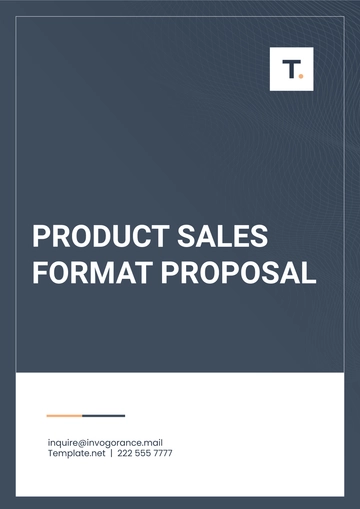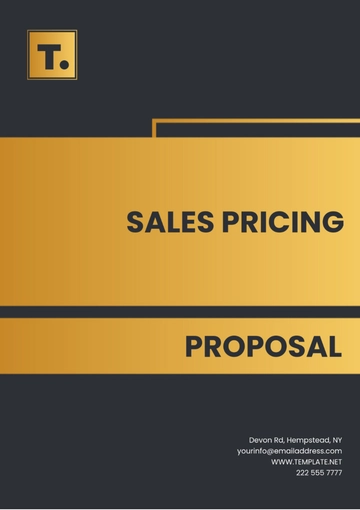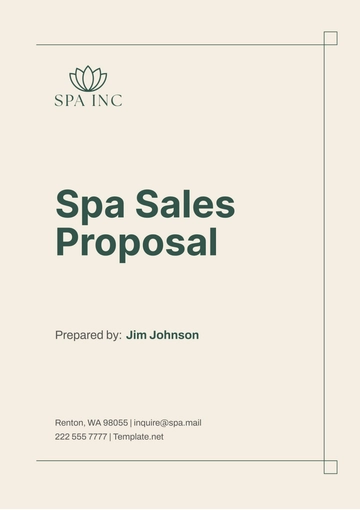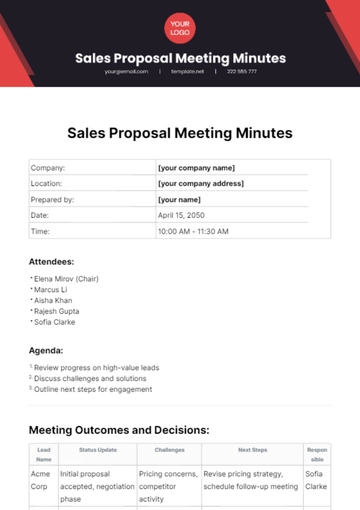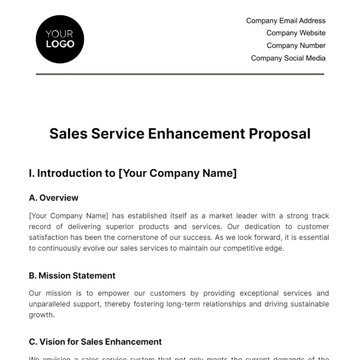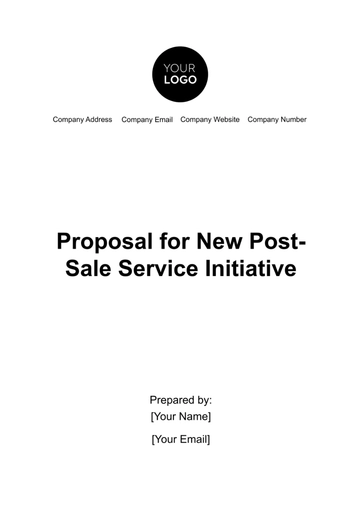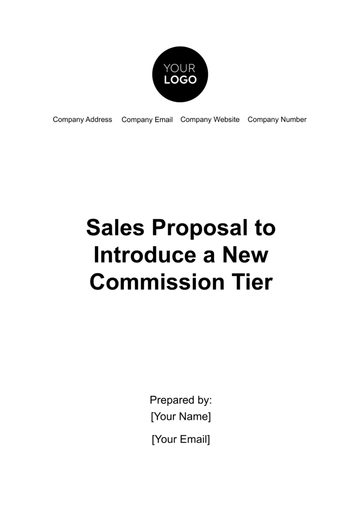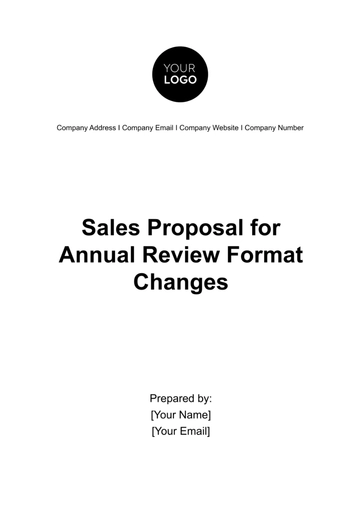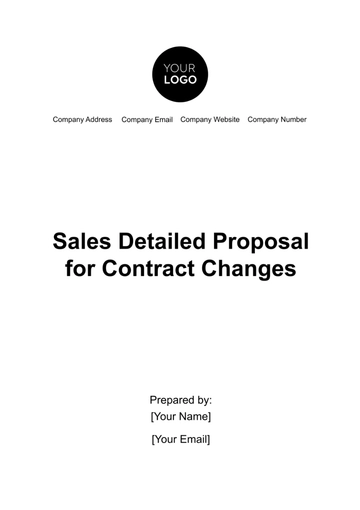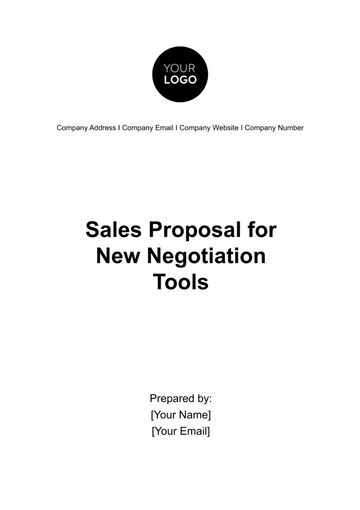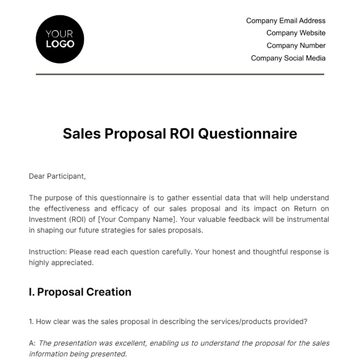Free Sales Bulk Sales Proposal SOP
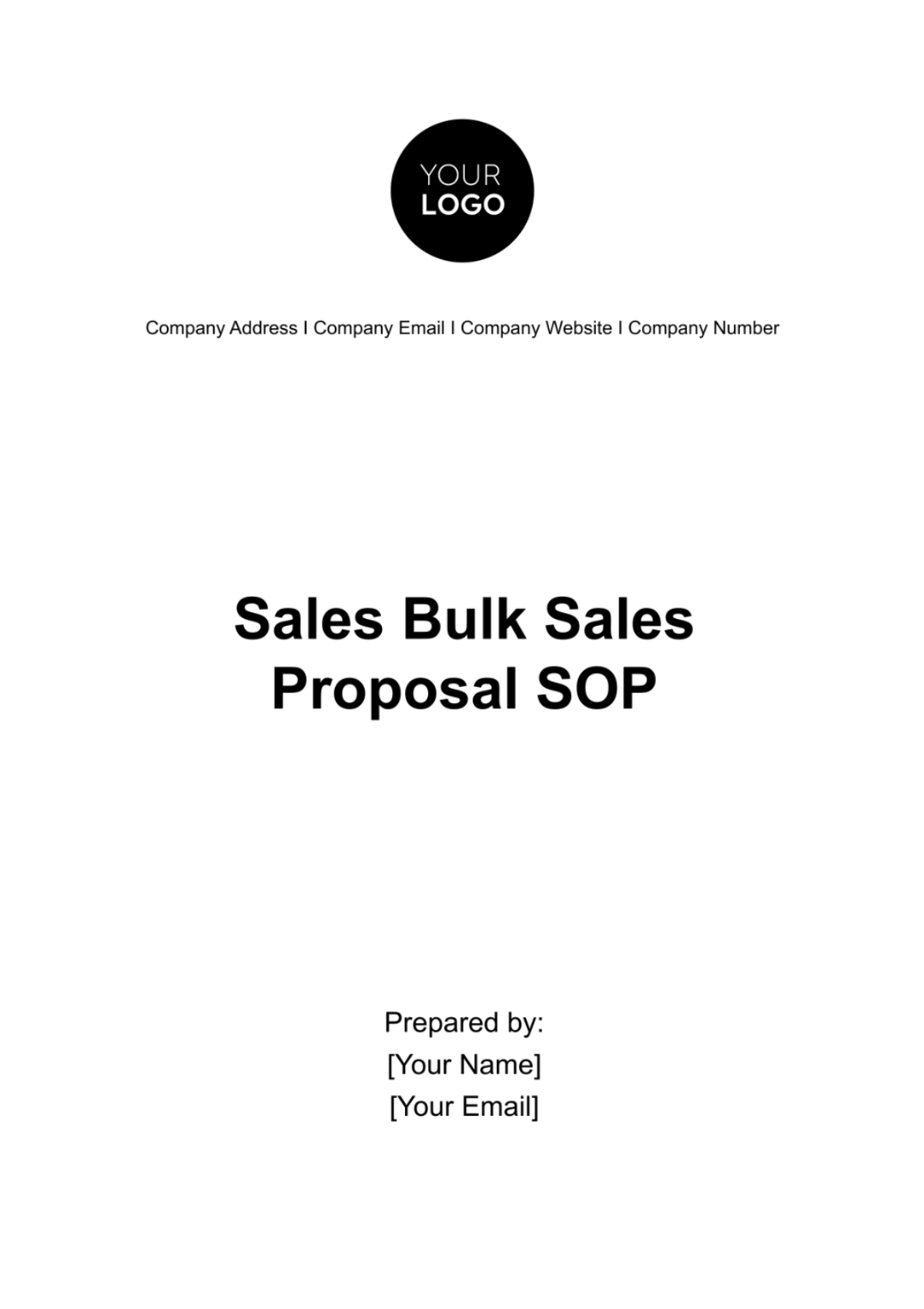
I. Introduction
Purpose
The purpose of this Sales Bulk Sales Proposal SOP is to establish a standardized and efficient approach for the creation and submission of bulk sales proposals within [Your Company Name]. It serves as a guiding document to ensure that every bulk sales proposal aligns with our company's goals and maintains the highest level of professionalism and quality.
This SOP aims to:
Streamline the proposal development process, reducing redundancies and errors.
Enhance the consistency and coherence of our proposals, reinforcing our brand identity.
Optimize our sales team's efforts by providing them with a clear and structured framework.
Increase the likelihood of securing bulk sales contracts and expanding our market reach.
Scope
The scope of this SOP extends to all members of the sales team, including sales managers, representatives, and associates, involved in the creation and submission of bulk sales proposals at [Your Company Name]. It encompasses every stage of the proposal lifecycle, from the initial gathering of information to the post-sales activities.
This SOP applies to the following key activities:
Identifying prospective clients and assessing their requirements for bulk purchases.
Researching the market and competitors to gain insights and maintain our competitive edge.
Developing compelling proposals tailored to individual client needs.
Formulating a competitive pricing strategy that aligns with our financial objectives.
Strategizing sales approaches, targeting the right market segments and employing suitable sales channels.
II. Proposal Preparation
Gathering Information
Before embarking on the process of creating a bulk sales proposal, it is crucial to start with a solid foundation of information. This initial step involves systematically gathering all necessary details and data to ensure that the proposal aligns with the client's needs and expectations.
Purpose of Gathering Information
The primary purpose of gathering information is to gain a comprehensive understanding of the client's requirements, market dynamics, and competitive landscape. This process serves as the basis for tailoring the proposal to meet the client's specific needs and to position our offerings effectively in the market.
Key Steps in Gathering Information
Client Needs Assessment: Initiate discussions with the prospective client to identify their precise requirements. This may include product specifications, quantities, delivery schedules, and any special requests or preferences.
Market Analysis: Conduct thorough research on the target market. Analyze market trends, demand patterns, and potential growth areas. Identify competitors and their offerings.
Legal and Regulatory Considerations: Ensure compliance with all relevant laws and regulations pertaining to bulk sales, contracts, and product specifications.
Resource Evaluation: Assess our company's capabilities, including production capacity, resources, and supply chain readiness to fulfill the bulk order.
Risk Assessment: Identify potential risks associated with the proposal, such as supply chain disruptions, pricing fluctuations, or legal issues. Develop strategies to mitigate these risks.
III. Defining Objectives
Clear and well-defined objectives are critical for the success of any bulk sales proposal. By establishing specific goals, the sales team can work towards achieving them with focus and determination.
Purpose of Defining Objectives
Defining objectives serves as a roadmap for the entire proposal development process. It provides a sense of purpose and direction, enabling the team to align their efforts with the overarching goals of the proposal.
Key Components of Defining Objectives
Revenue Targets: Specify the desired revenue or sales figures that the proposal aims to achieve. This may include both short-term and long-term revenue goals.
Market Expansion: If applicable, outline the goals for expanding the market share or entering new markets through the bulk sales proposal.
Client Retention: If the proposal targets existing clients, define objectives related to retaining and strengthening relationships with these clients.
Profitability: Include objectives related to maintaining or improving profitability while offering competitive pricing.
Timeline: Establish a clear timeline for achieving these objectives, considering proposal development, submission, negotiation, and contract finalization.
Quality Assurance: If applicable, set quality standards that the proposal must meet in terms of product or service quality.
IV. Proposal Creation
A. Executive Summary
The executive summary is a critical component of the bulk sales proposal as it provides a concise yet compelling overview of the entire proposal. This section is often the first part that potential clients and decision-makers read, so it must grab their attention and convey the proposal's key points effectively.
Purpose of the Executive Summary
The purpose of the executive summary is to provide a brief snapshot of the proposal's most important aspects, including its value proposition, benefits to the client, and a summary of key terms. It serves as a powerful tool to pique the client's interest and encourage them to delve deeper into the proposal.
B. Company Overview
A comprehensive company overview is essential to establish credibility and build trust with potential clients. This section should paint a clear picture of [Your Company Name] and its capabilities.
Purpose of the Company Overview
The purpose of the company overview is to introduce [Your Company Name] to the client, showcase its expertise, and provide context for the proposal. It helps the client understand why [Your Company Name] is a reliable partner.
V. Pricing Strategy
A. Cost Analysis
A robust pricing strategy is essential to determine the appropriate pricing structure for the bulk sales proposal. Cost analysis is a fundamental step in this process.
Purpose of Cost Analysis
The purpose of cost analysis is to calculate the true cost of providing the products or services outlined in the proposal. This includes direct costs (materials, labor, production) and indirect costs (overheads, administrative expenses) associated with fulfilling the proposal.
B. Competitive Pricing
Competitive pricing is a critical aspect of the bulk sales proposal. It ensures that our pricing remains attractive to clients while positioning us favorably in the market.
Purpose of Competitive Pricing
The purpose of competitive pricing is to set prices that are in line with or superior to what competitors offer, while also addressing the client's budget constraints.
VI. Sales Strategy
A. Target Market
Identifying and defining the target market is a pivotal step in creating a successful bulk sales proposal. Understanding the specific audience you intend to reach ensures that your proposal is tailored to their needs and preferences.
Purpose of Target Market Identification
The purpose of identifying the target market is to focus your sales efforts and resources on the most promising customer segments. This targeted approach increases the efficiency and effectiveness of your proposal.
B. Sales Channels
Determining the appropriate sales channels is crucial to reaching your target market effectively. Different sales channels have unique advantages and may be more suitable for specific products or services.
Purpose of Sales Channels Selection
The purpose of selecting sales channels is to establish the most efficient and cost-effective methods for reaching and engaging with potential clients in your target market.
C. Sales Team
A capable and motivated sales team is essential for executing the sales strategy effectively. This section outlines the roles and responsibilities of team members involved in the bulk sales proposal process.
Purpose of Sales Team Structure
The purpose of defining the sales team structure is to ensure that each team member understands their role and responsibilities, leading to a coordinated and successful sales effort.
VII. Proposal Submission
A. Formatting and Layout
The appearance and structure of the bulk sales proposal play a significant role in making a positive impression on the client. Professional formatting and layout are key to presenting the proposal in an organized and appealing manner.
Purpose of Formatting and Layout
The purpose of formatting and layout is to ensure that the proposal is visually engaging, easy to read, and conveys a sense of professionalism and attention to detail.
B. Proofreading and Review
Error-free content is essential to maintain professionalism and credibility. Proofreading and reviewing the proposal before submission are critical to catching any typos, grammatical errors, or inconsistencies.
Purpose of Proofreading and Review
The purpose of proofreading and review is to ensure that the proposal is free from errors, presents a polished image of [Your Company Name], and effectively communicates the intended message.
C. Submission Deadline
Meeting submission deadlines is crucial to maintaining professionalism and client trust. This section outlines the process for adhering to submission deadlines.
Purpose of Submission Deadline Management
The purpose of submission deadline management is to ensure that the proposal is submitted to the client within the agreed-upon timeframe, reflecting [Your Company Name]'s commitment to reliability.
VIII. Follow-Up Process
A. Client Communication
Effective communication with the client after submitting the proposal is crucial for maintaining engagement and addressing any inquiries or concerns they may have. This section outlines the key aspects of client communication in the follow-up process.
Purpose of Client Communication
The purpose of client communication is to foster a positive relationship, demonstrate our commitment to their needs, and ensure they have all the information required to make an informed decision.
B. Handling Objections
Client objections are a natural part of the sales process. Effectively addressing objections demonstrates our dedication to understanding and resolving the client's concerns.
Purpose of Handling Objections
The purpose of handling objections is to overcome client hesitations and reservations, increasing the likelihood of securing the bulk sales contract.
C. Negotiation
Negotiation is often a critical step in finalizing a bulk sales contract. Effective negotiation ensures that both parties reach mutually beneficial terms.
Purpose of Negotiation
The purpose of negotiation is to facilitate a productive discussion with the client, balancing their needs with [Your Company Name]'s objectives, ultimately leading to a successful agreement.
IX. Closing the Deal
A. Contract Preparation
Once negotiations have resulted in mutually agreeable terms, the next step is to prepare a formal contract that outlines all aspects of the bulk sales agreement.
Purpose of Contract Preparation
The purpose of contract preparation is to document the terms, conditions, and responsibilities of both parties, ensuring legal and operational clarity throughout the partnership.
B. Legal Review
Legal review is a critical step in ensuring the contract's legality, enforceability, and compliance with all relevant laws and regulations.
Purpose of Legal Review
The purpose of legal review is to mitigate legal risks, protect [Your Company Name]'s interests, and ensure that the contract is a legally binding agreement.
C. Finalizing Terms
The finalization of contract terms involves the last steps before the contract is executed, ensuring that all parties are in agreement and prepared to move forward.
Purpose of Finalizing Terms
The purpose of finalizing terms is to confirm that all parties fully understand and accept the contract's contents, and they are ready to proceed with the bulk sales agreement.
X. Post-Sales Activities
A. Delivery and Fulfillment
Efficient and reliable delivery and fulfillment processes are critical to ensuring that the client receives their bulk order as promised, meeting their expectations and maintaining satisfaction.
B. Customer Support
Effective customer support is essential for maintaining a positive and lasting relationship with the client. It ensures that their needs are met even after the bulk sale is completed.
C. Feedback Collection
Feedback collection is a valuable process that allows [Your Company Name] to gather insights from the client's experience and use that feedback to improve future proposals and operations.
XI. Performance Evaluation
A. Key Performance Indicators (KPIs)
Measuring the performance of bulk sales proposals is essential for assessing their effectiveness and impact on the organization's goals. The purpose of measuring KPIs is to quantitatively assess the success of bulk sales proposals, identify areas of improvement, and make data-driven decisions.
B. Sales Metrics
In addition to KPIs, specific sales metrics provide a detailed view of the performance of bulk sales proposals and the overall sales process. The purpose of tracking sales metrics is to assess the effectiveness of various sales activities, allowing for targeted improvements and optimizations.
XII. Conclusion and SOP Maintenance
A. Conclusion
The conclusion of the Sales Bulk Sales Proposal SOP emphasizes the importance of adhering to the established procedures and continuously striving for excellence in proposal development. The purpose of the conclusion is to reiterate the significance of following the SOP and maintaining a commitment to professionalism and quality.
B. SOP Maintenance
SOP maintenance is an ongoing process that ensures that the Sales Bulk Sales Proposal SOP remains relevant, up-to-date, and aligned with [Your Company Name]'s goals.
- 100% Customizable, free editor
- Access 1 Million+ Templates, photo’s & graphics
- Download or share as a template
- Click and replace photos, graphics, text, backgrounds
- Resize, crop, AI write & more
- Access advanced editor
Optimize your sales proposal process with our Sales Bulk Sales Proposal SOP Template from Template.net. This structured template provides a step-by-step standard operating procedure (SOP) for handling bulk sales proposals efficiently. Streamline your sales operations, ensure consistency, and boost productivity. Download now to enhance your bulk sales proposal process in just a few clicks! Accelerate your sales success today.
You may also like
- Business Proposal
- Research Proposal
- Proposal Request
- Project Proposal
- Grant Proposal
- Photography Proposal
- Job Proposal
- Budget Proposal
- Marketing Proposal
- Branding Proposal
- Advertising Proposal
- Sales Proposal
- Startup Proposal
- Event Proposal
- Creative Proposal
- Restaurant Proposal
- Blank Proposal
- One Page Proposal
- Proposal Report
- IT Proposal
- Non Profit Proposal
- Training Proposal
- Construction Proposal
- School Proposal
- Cleaning Proposal
- Contract Proposal
- HR Proposal
- Travel Agency Proposal
- Small Business Proposal
- Investment Proposal
- Bid Proposal
- Retail Business Proposal
- Sponsorship Proposal
- Academic Proposal
- Partnership Proposal
- Work Proposal
- Agency Proposal
- University Proposal
- Accounting Proposal
- Real Estate Proposal
- Hotel Proposal
- Product Proposal
- Advertising Agency Proposal
- Development Proposal
- Loan Proposal
- Website Proposal
- Nursing Home Proposal
- Financial Proposal
- Salon Proposal
- Freelancer Proposal
- Funding Proposal
- Work from Home Proposal
- Company Proposal
- Consulting Proposal
- Educational Proposal
- Construction Bid Proposal
- Interior Design Proposal
- New Product Proposal
- Sports Proposal
- Corporate Proposal
- Food Proposal
- Property Proposal
- Maintenance Proposal
- Purchase Proposal
- Rental Proposal
- Recruitment Proposal
- Social Media Proposal
- Travel Proposal
- Trip Proposal
- Software Proposal
- Conference Proposal
- Graphic Design Proposal
- Law Firm Proposal
- Medical Proposal
- Music Proposal
- Pricing Proposal
- SEO Proposal
- Strategy Proposal
- Technical Proposal
- Coaching Proposal
- Ecommerce Proposal
- Fundraising Proposal
- Landscaping Proposal
- Charity Proposal
- Contractor Proposal
- Exhibition Proposal
- Art Proposal
- Mobile Proposal
- Equipment Proposal
- Student Proposal
- Engineering Proposal
- Business Proposal



